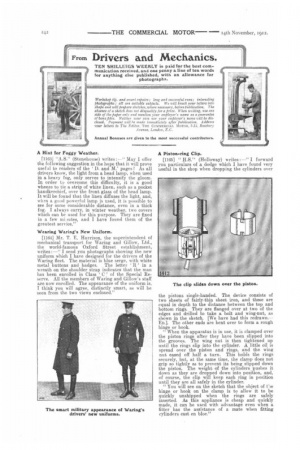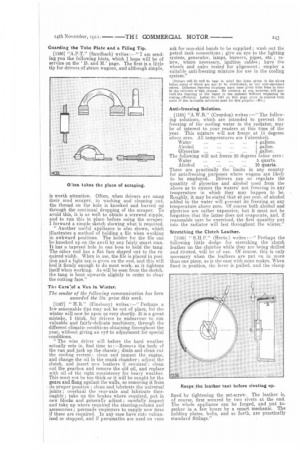1 From Drivers and Mechanics.
Page 22

Page 23

If you've noticed an error in this article please click here to report it so we can fix it.
munication received, and one penny a line of ten words TEN SHILLINGS WEEKLY is paid for the best comfor anything else published, with an allowance for rrS4726, $
photographs. 255
Workshop tiP, and smart rePairs ; long and succeastal runs; interesting Photographs ; ai art suitable subjects. We will knock your letters into shape and will prepare sketches, where necessary, before Publication. The absence of a sketch does not disqualify for a prize. When we iting, use one side of the Paper only and mention your employer's name as a guarantee of bona fides. Neither your own nor your employer's name will be disclosed. Payment will he made immediately after iiublical1412. Address your letters to The Editor, THE COMMERCIAL MOTOR, 7-15, Rosebery
A venue, London, E.C.
Annual Bonuses are given to the most successful contributors.
A Hint for Foggy Weather.
1-11G3j "A.S." (Stonehouse) writes :—" May I offer the following suggestion in the hope that it will prove useful to readers of the I). and M.' pages ? As all drivers know, the light from a head lamp, when used in a heavy fog, only serves to intensify the gloom. In order to overcome this difficulty, it is a good wheeze to tie a strip of white linen, such as a pocket handkerchief, over the front glass of the head lamp. it will be found that the linen diffuses the light, and, when a good powerful lamp is used, it is possible to see for some considerable distance, even in a thick fog. I always carry, in winter weather, two covers which can be used for this purpose. They are fixed in a few mi mtes, and I have found them of the greatest service."
Wearing Waring's New Uniform, [1161] Mr. T. E. Harrison, the superintendent of mechanical transport for Waring and Gillow, Ltd., the world-famous Oxford Street establishment,
writes I send you photographs showing the new uniform which I have designed for the drivers of the Waring fleet. The material is blue serge, with white metal buttons and badges. The letter 'II 2 in a wreath on the shoulder strap indicates that the man has been enrolled in Class C of the Special Reserve. All the members of Waring and Gillow's staff are now enrolled. The appearance of the uniform is, I think you will agree, distinctly smart, us will be seen from the two views enclosed." A Piston-ring Clip.
[1165] " H.S." (Holloway) writes :—" I forward you particulars of a dodge which I have found very useful in the shop when dropping the cylinders over
the pistons single-handed. The device consists of two sheets of fairly-thin sheet iron, and these are equal in depth to the distance between the top and bottom rings. They are flanged over at two of the edges and drilled to take a bolt and wing-nut, as shown in the sketch. [We have had this redrawn.— En.]. The other ends are bent over to form a rough hinge or hook. "When the apparatus is in use, it is clamped over the piston ring e after they have been slipped into the grooves. The wing nut is then tightened up until the rings slip into the cylinder. A little oil is spread over the piston and rings, and the wing nut eased off half a turn. This holds the rings securely, but, at the same time, the clamp does not grip so tightly as to prevent its being slipped down the piston. The weight of the cylinders pushes it down as they are dropped down into position, and, of course, the clip will keep each ring in position until they are all safely in the cylinder. "You will see on the sketch that the object of tie hinge or hook on the clamp is to allow it to be quickly unshipped when the rings are safely inserted. As this appliance is cheap and quickly made, it can be used with advantage even when a fitter has the assistance of a mate when fitting cylinders cast en bloc." Guarding the Tube Plate and a Filing Tip.
[1166] "A.P.T." (Sandbach) writes :—" I am sending you the following hints, which I hope will be of service on the D. and M.' page. The first is a little tip for drivers of steam wagons, and although simple, is worth attention. Often, when drivers are using their mud scraper, in washing and cleaning out, the thread on the hole is knocked and burred up through the continual dropping of the scraper. To avoid this, it is as well to obtain a screwed nipple, and to run this in place before using the scraper. I forward a simple sketch showing what is required.
" Another useful appliance is also shown, which illustrates a method of holding a file when working in awkward positions. The holder for the file can be knocked up on the anvil by any fairly smart man. It has a tapered hole in one boss to hold the tang. The other end has a flat face shaped out to the required width. When in use, the file is placed in position and a light tap is given on the end, 'and this will bed it firmly enough to do most work, as it tightens itself when working. As will be seen from the sketch, the tang is bent upwards slightly in order to clear the cutting face."
The Care7of a Van in Winter.
The sender of the following communication has been awarded the 10s. prize this week.
[1167] " H.B." (Finsbury) writes Perhaps a few seasonable tips may not be out of place, for the winter will now be upon us very shortly. It is a great mistake, I think, for drivers to endeavour to, run valuable and fairly-delicate machinery, through the different, climatic conditions obtaining throughout the year, without giving an ey4 to adjustment for special conditions.
" The wise driver will before the hard weather actually sets in, find time to :—Remove the body of the van and jack up the chassis ; drain and clean cut the cooling system ; clean and inspect the engine, and change the oil in the crank chamber ; adjust the clutch, and insert new leathers if. renuired ; clean out the gearbox and remove the old oil, and replace with oil of the right consistency for heavy weather. This must not be. too thick or it will be caught by the gears and flung against the walls, so removing it from its proper position ; clean and lubricate the universal joints ; overhaul the rear-axle and lubricate thoroughly; take up the brakes where required, put in • new blocks and generally adjust ; carefully inspect and take up where required the steering-column and accessories ; persuade employers to supply new tires if these are required. In any case have cuts vulcanized or stopped, and if pneumatics are used en vans
ask for non-skid bands to be supplied ; wash out the petrol tank connections ; give an eye to the lighting system, generator, lamps, burners, pipes, etc.; renew, where necessary, ignition cables ; have the wheels and axles tested for alignment ; employ a suitable anti-freezing mixture for use in the cooling system."
[Drivers will do well to bear in mind the hints given in the above letter, many of which are apt to be overlooked, as our corr,spondent states. Different freezing inixtures have been given from time to time in the columns of ibis Jounce]. No mixture as yet, however, will prevent the freezing of the water in the radiator without impairing its cooling efficiency. Letter No. 1165 on this page gives in concise form some of the favoukite mixtures used for this purpose—En.] Anti-freezing Solution.
[1168] "A.W.B." (Croydon) writes :—" The following solutions, which are intended to prevent the
freezing of the cooling water in the radiator, may be of interest to your readers at this time of the year. This mixture will not freeze at 15 degrees above zero. All temperatures are Fahrenheit. Water ... ... ... ... 4 gallons.
Alcohol ... ... ... ... 1 gallon. Glycerine ... ___ ... ... gallon.
The following will not freeze 20 degrees below zero: Water ... ... ... ... 5 quarts. Alcohol ... ... ... ... 10 quarts.
These are practically the limits in any country for anti-freezing purposes where wagons are likely to be employed. Drivers can so regulate the
quantity of glycerine and alcohol used from the above as to ensure the waters' not freezing in any
temperature in which they may happen to be.
Roughly, it may be stated that 40 per cent. of alcohol added to the water will prevent its freezing at any
temperature above zero. Of course both alcohol and glycerine are rather expensive, but it must not be forgotten that the latter does not evaporate, and, if
reasonable care be exercised, the first quantity put into the radiator will last throughout the winter."
Stretching the Clutch Leather.
[1169] " S.H.P." (Herts.) writes ;--" Perhaps the following little dodge for stretching the clutch leather on the clutches while they are being drilled and riveted, will be of use. Of course, this is only necessary when the leathers are put on in more than one piece, as is the case with some makes. When fixed in position, the lever is pulled, and the clamp fixed by tightening the set-screw. The leather is, of course, first secured by two rivets at the end. The whole appliance can be forged, and put together in a few hours by a smart mechanic. The holding plates, bolts, and so forth, are practically standard fittings."
























